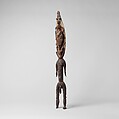Male Figure
Not on view
The peoples of the middle Ramu and Guam Rivers in northeast New Guinea practice, or practiced, a closely related series of sculptural traditions. Carvers in the region created distinctive human figures with flattened oval heads resembling masks and smaller fully modeled bodies whose trunks and limbs are often nearly cylindrical in cross section. With the exception of those of the Kominimung people, the significance of these figures remains undocumented. Kominimung figures portray bwongogo, ancestral spirits whose powers assure the success of agriculture, hunting, fishing, and other human endeavors. These figures are men’s sacred objects, kept and used within the precincts of the men’s ceremonial house. Some forms may only be seen by men, but during ceremonies, other types are raised briefly above the fence surrounding the ceremonial house, allowing women and children to catch a fleeting glimpse of the powerful ancestral spirits. Although any man may create ordinary utilitarian objects, figures and masks typically are made by skilled carvers, whose artistic talents are known and recognized within the community.
Due to rights restrictions, this image cannot be enlarged, viewed at full screen, or downloaded.

